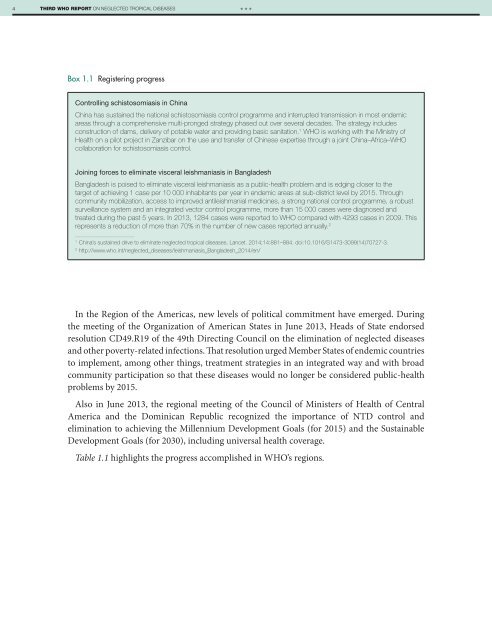1A9bnbK
1A9bnbK
1A9bnbK
You also want an ePaper? Increase the reach of your titles
YUMPU automatically turns print PDFs into web optimized ePapers that Google loves.
4 THIRD WHO REPORT ON NEGLECTED TROPICAL DISEASES<br />
***<br />
Box 1.1 Registering progress<br />
Controlling schistosomiasis in China<br />
China has sustained the national schistosomiasis control programme and interrupted transmission in most endemic<br />
areas through a comprehensive multi-pronged strategy phased out over several decades. The strategy includes<br />
construction of dams, delivery of potable water and providing basic sanitation. 1 WHO is working with the Ministry of<br />
Health on a pilot project in Zanzibar on the use and transfer of Chinese expertise through a joint China–Africa–WHO<br />
collaboration for schistosomiasis control.<br />
Joining forces to eliminate visceral leishmaniasis in Bangladesh<br />
Bangladesh is poised to eliminate visceral leishmaniasis as a public-health problem and is edging closer to the<br />
target of achieving 1 case per 10 000 inhabitants per year in endemic areas at sub-district level by 2015. Through<br />
community mobilization, access to improved antileishmanial medicines, a strong national control programme, a robust<br />
surveillance system and an integrated vector control programme, more than 15 000 cases were diagnosed and<br />
treated during the past 5 years. In 2013, 1284 cases were reported to WHO compared with 4293 cases in 2009. This<br />
represents a reduction of more than 70% in the number of new cases reported annually. 2<br />
_____________________<br />
1<br />
China’s sustained drive to eliminate neglected tropical diseases. Lancet. 2014;14:881–884. doi:10.1016/S1473-3099(14)70727-3.<br />
2<br />
http://www.who.int/neglected_diseases/leishmaniasis_Bangladesh_2014/en/<br />
In the Region of the Americas, new levels of political commitment have emerged. During<br />
the meeting of the Organization of American States in June 2013, Heads of State endorsed<br />
resolution CD49.R19 of the 49th Directing Council on the elimination of neglected diseases<br />
and other poverty-related infections. That resolution urged Member States of endemic countries<br />
to implement, among other things, treatment strategies in an integrated way and with broad<br />
community participation so that these diseases would no longer be considered public-health<br />
problems by 2015.<br />
Also in June 2013, the regional meeting of the Council of Ministers of Health of Central<br />
America and the Dominican Republic recognized the importance of NTD control and<br />
elimination to achieving the Millennium Development Goals (for 2015) and the Sustainable<br />
Development Goals (for 2030), including universal health coverage.<br />
Table 1.1 highlights the progress accomplished in WHO’s regions.


